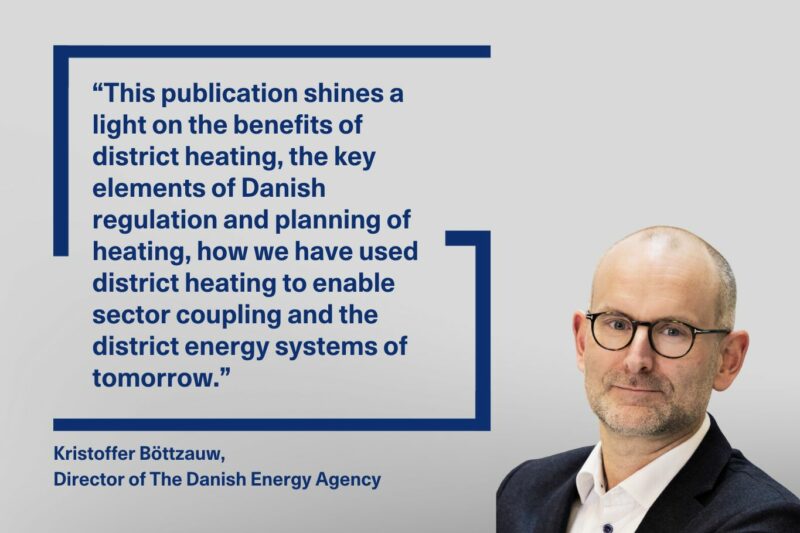News
Combined heat and power production
District heating
Offshore wind
+4
42%: Danish Wind Power Sets World Record Again


In 2015, Danish wind turbines once again set record. In total, the wind turbines generated 42.1 percent of the total Danish electricity consumption -the highest figure ever- and the highest share for some parts of the country. Last year, the figure was 39.1 percent - also this was a world record.
”The world record is important because it once again demonstrates that Denmark has pushed the boundaries for the significant role of wind power in a society’s electricity supply. This makes Denmark an invaluable showcase for the Danish wind industry. One thing is to present reports that say it is possible, but another is to show the world that Denmark can make it happen with success, which is something completely different. This attracts foreign delegations to Denmark and at the same time opens doors for Danish companies abroad,” says Martin Bøndergaard, Senior Advisor at the Danish Wind Industry Association.
-Related news: It's a Record! 39% of Denmark’s Electricity Consumption Covered by Wind in 2014
Behind the figures lies even more remarkable figures that illustrate that the Danish and European energy system is undergoing tremendous change and that renewable energy changes the way the power system is operated.
Many hours of 'wind surplus' in the power system
For more that 1460 out of 8760 hours of the year, the West Danish part of the power system (DK1) produced wind power that exceeded the total consumption in the Western part of Denmark.
- It is as such not unusual with hours where wind production exceeds consumption, but that this is now the case up to one sixth of the time in the Western Danish grid illustrates that with increasingly more fluctuating production, we benefit even more from import and export across international borders. If we for some hours have a lot of wind energy, producers sell it to consumers in Norway, Sweden and Germany, and vice versa; in Denmark we buy e.g. hydropower from Norway, solar energy from Germany and power stattion electricity from Sweden, when it is worthwhile, said Mr Vittrup, Energy Strategic advisor in Energinet.dk's Department of Energy analysis.
-Related news: Royal Inauguration of New Danish-Norwegian Power Connection
He stresses that the Danish power plants and Combined Heat and Power plants still play a large and important role in the Danish electricity supply. The power plants provide flexibility and produces electricity when there is little production from wind and sun.
Wind trade 55 percent in Western Denmark
Most Danish wind turbines are situated in Western Denmark, and in 2015 Danish wind turbines in Western Denmark produced wind power corresponding to 55 percent of the West Danish electricity consumption.
In Eastern Denmark (DK2), the figure was 23 percent. And in Eastern Denmark, there were no hours where wind production exceeded the total consumption in Eastern Denmark.
Of 8760 hours of the year, Western Denmark had 65 hours, and Eastern Denmark 36 hours with 'negative prices'. These are hours with so much electricity that producers have to pay to get rid of the power. Negative prices are an incentive to e.g. wind turbine owners to turn off the wind turbines for a few hours when there is more power in the electricity market than consumers are willing to purchase.
The European market is a good idea
- We experience negative prices in less than one percent of the time. So although we have a lot of hours, where the wind turbines, solar cells, power plants, etc. in total have a bigger production than our consumption, it does not mean that it is bad business. On the contrary, it is good business for Denmark to be part of a larger European market. I usually say that if a farmer has problems selling his milk three days a year, it does not mean that he dismantles the farm, or that it is a bad business the other 362 days of the year, said Mr Vittrup.
-Related news: IEA: Denmark Best in Europe for Wind Turbines
The Danish Parliament’s goal is that wind power in 2020, should constitute 50 percent of the Danish electricity consumption. Forecasts indicate that the goal will be achieved. Even though the number of wind turbines will increase in the coming years, there is no immediate prospect showing that the number of hours with negative prices will change significantly.
2015 was extra windy
Overall, Denmark had more than 409 hours of the year, where the wind production exceeded the total Danish electricity consumption.
One of the main reasons that 2015 became a record year is that it has been a very windy year, whereas 2014 was a normal wind year. On the contrary, two wind farms, Anholt and Horns Rev 2, has been out of service for 1 and 2 months due to cable faults. If there had not been this extraordinary long time period of cable fault, the wind percentage would have been approximately 43.5 percent.
Wind Power share of total power consumption over the past 10 years:
2015: 42.1%
2014: 39.1%
2013: 32.7%
2012: 30.0%
2011: 28.3%
2010: 22.0%
2009: 19.4%
2008: 19.3%
2007: 19.9%
2006: 17.0%
2005: 18.7%
“We must continue to set sensational world records as part of the Danish showcase. This way, we can reap the benefits of our many years of focus on wind energy. This is exactly what makes the Danish energy policy a fantastic growth engine,” explains Martin Bøndergaard.
Denmark operating without central power stations for 24 hours
Also, 2015 was a special year in other respects. For the first time ever, the Danes were powered for a whole day, without any of the country's large central power plants running. This has never happened before for an entire day. On September 2, the Danes received electricity purely from wind turbines, photovoltaics, decentralised combined heat and power plants, and through imports from neighboring countries.
In 2015, Denmark also experienced the hour with the highest proportion of wind energy relative to the total electricity consumption ever. It happened on July 26 from 6:00 am to 7:00 am. Here, the share of wind power constituted 138.7 percent. In 2014, the day with the highest proportion of wind was 132.1 percent.
- SEE THE TOTAL LIST OF THE TOP 24 GREEN NEWS FROM 2016
Source: Energinet.dk / Press release Danish Wind Industry Association
You should consider reading
solutions
Combined heat and power production
+6
CopenHill: The story of the iconic waste-to-energy plant
20 November 2024solutions
Energy efficiency in buildings
+2















